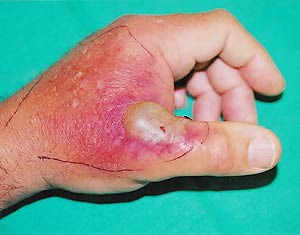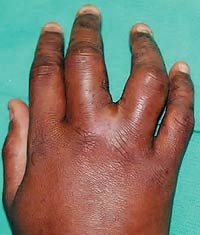A patient with a joint abscess
This patient developed an abscess over the metacarpophalangeal joint of the thumb after an accidental cut with a kitchen knife.

What is your diagnosis? Click to the next page to find out.
Answer
The answer is methicillin-resistant Staphylococcus aureus.
Surgeons at one hospital system found that MRSA may become a more common bacteriologic flora of hand infections, and if so, surgeons must adjust their choices for empiric antibiotics.
After noticing a marked increase in the number of community-acquired methicillin-resistant Staphylococcus aureus (MRSA) cases, surgeons at the Greenville Hospital System in South Carolina conducted a retrospective chart review of all orthopedic consultations done for hand infections from November 2003 to October 2005.
“In the first 6 months of the collection period, we had no cases [of MRSA], but by the last 6 months of the collection period, 77% of all our hand infections were being caused by community-acquired MRSA,” according to C. Dana Clark, MD, who spoke at the American Academy of Orthopaedic Surgeons 74th Annual Meeting.
These findings put the surgeons on the lookout for more cases and urged them to change their treatment algorithm.
“Unfortunately, there is very scarce literature to support this practice, and there have been virtually no recent studies that have addressed this topic,” Clark said.


Rise in MRSA
Led by Kyle J. Jeray, MD, Clark and his co-investigators evaluated 93 patients who presented with hand infections at their institution over the two-year period.
They found documented culture results in 72 of the patients. The 21 patients without culture results included 14 cellulitis cases, five paronychia cases, one felon case and one finger abscess, Clark said.
Culture results revealed that MRSA caused 50% of all hand infections at Greenville Hospital during the two-year period. Methicillin- sensitive S. aureus caused 18%, beta-hemolytic Streptococcus caused 8% and 14% of patients had no growth, Clark said.



Ineffective antibiotics
Surgeons typically expect that methicillin-sensitive S. aureus or beta-hemolytic S. cause most hand infections, Clark said, and so they tend to prescribe beta-lactam antibiotics, such as cephazolin [Ancef; GlaxoSmithKline] and cephalexin [Keflex; Eli Lilly and Co.], which are both ineffective at treating MRSA.
In this study, “We found that [78%] of patients were given an ineffective antibiotic, and virtually all of these were Keflex,” Clark said.
The researchers found no difference in the demographics between patients with MRSA and those with non-MRSA as far as age, gender and race.
Recommendations for cases
Based on these findings, Clark, Jeray and their colleagues recommended that surgeons increase clinical awareness of this problem and strongly consider MRSA in diagnosing acute hand infections.
Specifically, they recommended bedside incision and drainage, cultures and a course of sulfamethoxazole and trimethoprim [Bactrim; F. Hoffmann-LaRoche Ltd.] for superficial infections in healthy patients.
“If there is a high degree of cellulitis, our infectious disease doctors recommend adding rifampin to increase tissue profusion of the antibiotic. If group A Streptococcus is strongly suspected, Keflex should be added to ensure coverage,” Clark said.
In those patients with deep infections or multiple comorbidities, the surgeons recommend hospital admission, formal irrigation and debridement, and intravenous vancomycin, Clark said. – by Tina DiMarcantonio
For more information:
- C. Dana Clark, MD, PGY4 resident, can be reached at Greenville Hospital System, 701 Grove Road, 2nd Floor Support Tower, Greenville, SC 29605; (864) 455-7878. He has no direct financial interest in the products discussed in this article, nor is he a paid consultant for any companies mentioned.
- Kyle J. Jeray, MD, can be reached at Greenville Hospital System; kjeray@ghs.org. He has no direct financial interest in the products discussed in this article, nor is he a paid consultant for any companies mentioned.
- Clark CD, Jeray KJ, Jones JL, et al. Incidence of hand infections and their bacterial flora. #366. Presented at the American Academy of Orthopaedic Surgeons 74th Annual Meeting. Feb. 14-18, 2007. San Diego.
Spot the Rash is a monthly case study featured in Infectious Diseases in Children designed to test your skills in pediatric dermatology issues.
